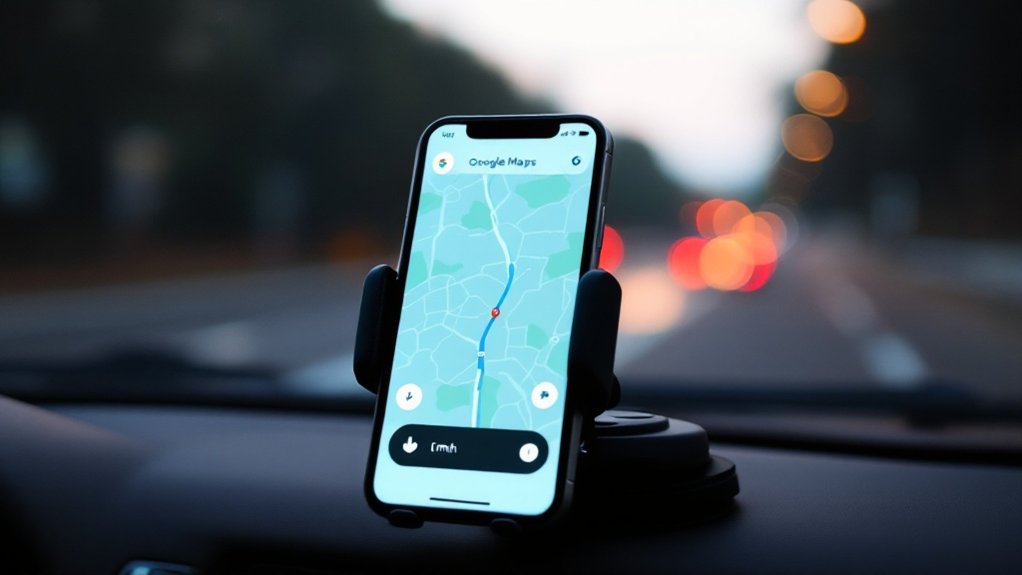SEO in 2025 isn’t your old keyword game anymore. You’re facing AI-powered algorithms that prioritize user intent, conversational queries, and experience metrics. Core Web Essentials now make or break your rankings—keep that LCP under 2.5 seconds or kiss visibility goodbye. Zero-click searches capture 60% of traffic, so structure content accordingly. Voice search? Huge. Featured snippets? Critical. E-E-A-T signals? Non-negotiable. The deeper you go, the more your competition will wonder what hit them.
Explorer Insights
- AI algorithms now prioritize user intent and natural language patterns over traditional keyword optimization approaches.
- Core Web Vitals metrics (LCP, INP, CLS) directly impact search rankings and must meet specific performance thresholds.
- Featured snippets and zero-click strategies are essential as they capture 60% of Google traffic without website visits.
- E-E-A-T signals require robust author profiles, regular content updates, and proper citations to establish credibility.
- Content clustering with pillar pages and schema markup strengthens semantic relationships and improves search visibility.
AI-Powered Search Algorithms: Understanding the New Landscape
Google’s algorithm updates in 2025 have completely transformed the SEO battlefield—forget everything you thought you knew.
You’ll need to adapt quickly to these AI-driven changes, which now prioritize user intent over traditional keyword stuffing (shocking, right?).
Your SEO strategy must evolve to embrace natural language patterns and thorough content that actually answers questions, not just repeats them.
AI-powered SEO tools like ContentShake AI and Copy.ai are now essential for generating optimized content and adapting to rapid search engine changes.
Key Google Algorithm Updates in 2025
As we plunge into 2025, the search algorithm landscape has transformed beyond recognition, with AI now steering the ship more than ever before.
Your SEO strategies must adapt—period. BERT and RankBrain aren’t just buzzwords anymore; they’re the gatekeepers of Google search results.
Core Web Essentials? Non-negotiable. If your site’s slow, you’re toast. Simple as that.
The algorithms now understand user intent with almost scary precision, making keyword stuffing about as effective as a chocolate teapot.
SEO content isn’t just about words on a page. It’s about answering questions before users even finish typing them.
Zero-click searches are eating up traffic, and E-E-A-T requirements are tightening. Semantic search is king now. Deal with it.
Behind the scenes, search engines leverage large language models trained on massive datasets to interpret intent and deliver highly relevant results.
Adapting Your SEO Strategy to Algorithm Changes
The AI revolution in search isn’t coming—it’s already here, reshaping everything we thought we knew about SEO.
Get with the program or disappear from search results. Simple as that.
Your seo strategy must evolve beyond traditional keyword stuffing. BERT and similar AI systems don’t just read words—they understand conversations.
Yeah, actual context matters now.
Algorithm changes demand content that addresses entire topic clusters, not just isolated terms.
User engagement metrics? They’re watching those too. Time spent on page. Click-through rates. Everything.
Maintaining search rankings requires constant content updates based on performance data.
The days of “set it and forget it” are dead. Seriously, they’re decomposing in SEO’s graveyard.
Track those algorithm shifts. Adapt quickly.
Or watch competitors steal your traffic while you cling to outdated tactics.
AI search systems increasingly favor sites that demonstrate human-like reasoning processes, so explain your logic, show your steps, and let your expertise work for you.
User Intent Optimization: Beyond Keywords to Conversational Search
You’re now talking to search engines like you talk to your friends, and they get it.
Voice search has exploded, with nearly half of all searches coming from people asking questions out loud rather than typing them.
This shift means your SEO strategy needs to match how real humans actually speak—messy, conversational, and full of those long-tail phrases nobody used to bother optimizing for.
As search engines become more sophisticated at understanding natural language processing, optimizing for intent and context is just as crucial as focusing on keywords.
The Rise of Voice Search and Natural Language Queries
Voice search has fundamentally transformed how users interact with search engines, creating a seismic shift in SEO strategies. By 2025, over half of all searches will be voice-based. Let that sink in.
Your content needs to sound like actual humans talking—because that’s exactly what voice search responds to. Natural language queries don’t look like typed searches; they’re longer, question-based, and conversational.
Users aren’t typing “best pizza NYC” anymore—they’re asking, “Where can I find the best pizza near me that’s still open?”
AI algorithms are getting freakishly good at understanding user intent behind these spoken queries. Structure your content with clear headings that directly answer questions people actually ask.
Blunt truth? If you’re still optimizing solely for typed keywords, you’re already behind. Voice search isn’t coming—it’s here.
A crucial step in optimizing for voice and natural language is ensuring your content aligns with user intent, using clear and conversational language to address specific queries and scenarios.
Core Web Vitals and Experience Metrics in 2025
Core Web Vitals aren’t just fancy metrics—they’re your website’s report card in 2025’s SEO landscape.
You’ll need to obsessively monitor LCP (loading under 2.5 seconds), INP (response times below 100ms), and CLS (visual stability score under 0.1) if you want any shot at ranking well.
Tools like PageSpeed Insights and Chrome DevTools will become your new best friends as you frantically optimize these metrics that search engines now prioritize over practically everything else.
Just like optimizing for Core Web Vitals, understanding time and space complexity helps ensure your site remains efficient and scalable as user demands grow.
Measuring LCP, INP, and CLS for Better UX
As we hurtle toward 2025, understanding Core Web Essentials isn’t just nice-to-have—it’s survival.
Measuring LCP, INP, and CLS directly impacts your search rankings and user experience. That 2.5-second LCP target? Miss it and watch visitors vanish.
Your INP needs to hit 200 milliseconds or less. Period. Users won’t wait while your fancy JavaScript decides to wake up. They’ll bounce faster than you can say “algorithm update.”
CLS below 0.1 isn’t negotiable anymore. Nobody enjoys reading a paragraph that suddenly jumps because your ad finally loaded. Surprise—users hate surprises!
Regular audits aren’t optional. The metrics don’t lie, even when your design team does.
Applying query optimization basics to your analytics platform can further streamline data retrieval and ensure experience metrics are measured without delay.
Tools to Audit and Improve Core Web Vitals
While everyone’s busy obsessing over flashy AI tools, your Core Web Essentials could be silently tanking your rankings.
Let’s cut to the chase—you need reliable analytics tools to measure what matters.
Google’s PageSpeed Insights? Non-negotiable. It breaks down your LCP, INP, and CLS scores in seconds.
Chrome DevTools? A lifesaver for identifying those annoying layout shifts destroying your user experience.
Lighthouse audits offer actionable fixes—not just empty metrics. And yeah, they’re free.
Don’t sleep on Chrome User Experience Report data either. Real-world website traffic insights beat hypotheticals any day.
The truth hurts: optimizing metrics isn’t sexy work, but it’s what separates page-one rankings from digital obscurity in 2025.
Your competitors are already doing it.
Similar to how dimensionality reduction can streamline complex datasets for analysis, leveraging the right tools ensures your site’s performance issues don’t go unnoticed.
Zero-Click Search Strategies for Maximum Visibility

Featured snippets are the royal thrones of zero-click searches—capturing one means you’ve won 60% of Google’s traffic without a single user hitting your website.
You’ll need to structure your content with crystal-clear headings and provide immediate, value-packed answers that Google can’t resist displaying.
A strong problem definition and clear metrics are foundational to ensure your featured content aligns with user needs and achieves measurable success.
Featured Snippets and How to Win Them
People Also Ask (PAA) boxes are gold mines for your SEO strategy in 2025, showing you exactly what searchers want to know.
You’ll need to structure your content directly around these questions, using clear heading formats that mirror common queries and providing concise answers immediately after.
Content that addresses data cleaning and preprocessing in AI and other emerging topics is more likely to appear in featured snippets and PAA results.
Optimizing for People Also Ask Boxes
As search engines evolve, zero-click results have become prime digital real estate that you can’t afford to ignore. “People Also Ask” boxes now dominate search results pages, offering users instant answers without requiring them to click through to websites.
| Strategy | Implementation | Impact |
|---|---|---|
| Question Format | Structure content as direct Q&A | Immediate visibility |
| Long-tail Keywords | Use natural language phrasing | Matches user queries |
| Header Optimization | Place questions in H2/H3 tags | Improves context signals |
| Schema Markup | Add structured data | Enhances understanding |
Voice Search and Multi-Modal Content Optimization
Why are so many SEO professionals scrambling to adapt their strategies for voice search? Simple. Voice assistants are taking over, and if you’re not optimizing for them, you’re toast.
Voice search optimization isn’t just a trend—it’s survival. Your content needs to match user intent through natural language queries and long-tail keywords. Forget keyword stuffing. Think conversation.
Voice search demands authentic dialogue over manufactured keywords—speak your audience’s language or become digitally invisible.
- Structured data gives context to search engines—crucial for voice results
- Multi-modal content engages users across text, video, and audio formats
- Zero-click searches demand direct, concise answers to common questions
- Optimize video descriptions and image alt text for accessibility
- Natural language patterns trump robotic keyword phrases every time
Voice search isn’t coming. It’s here. Adapt or disappear from search results entirely.
E-E-A-T Signals: Building Authority in the AI Era

In the AI era, search engines won’t just scrutinize your content—they’ll judge your entire brand’s credibility through E-E-A-T signals.
You’ll need robust author profiles that showcase real credentials, not just fancy titles or vague “industry expert” claims.
Regularly updating your content isn’t optional anymore; it’s the difference between being seen as a trusted authority or becoming digital background noise that algorithms ignore.
Demonstrating Expertise with Author Profiles
The digital age of 2025 demands more than just well-written content—it requires proven expertise. Your author profiles aren’t just digital nameplates anymore; they’re your SEO secret weapons.
Search engines are getting smarter about who’s talking, not just what they’re saying.
- Display credentials prominently—degrees, certifications, years in the field. No fluff.
- Link to your published works on respected platforms. Reputation matters.
- Update your profile regularly with new qualifications. Static = forgotten.
- Include clear citations to primary sources. Back up your claims or get buried.
- Highlight specific experience in YMYL topics. Generic expertise won’t cut it.
E-E-A-T isn’t a suggestion—it’s survival. As AI gets pickier about trustworthiness, your credibility needs tangible proof.
Author profiles are no longer optional.
Updating Content for Accuracy and Freshness
Implement a quarterly content review process. It’s not optional anymore. Search engines are practically obsessed with freshness, and they’ll reward you for timely updates with improved search visibility.
Those dusty blog posts from 2021? They’re killing your credibility. Refresh them with current stats, new insights, and verified information. Then watch your traffic climb.
After updates, monitor user engagement metrics like it’s your job—because it is. These numbers tell you if your refresh worked or flopped.
In 2025’s SEO landscape, accuracy isn’t just nice—it’s necessary.
Semantic SEO and Structured Data Implementation
Semantic SEO isn’t just a fancy buzzword – it’s your ticket to content that actually answers what people are searching for.
You’ll need to implement schema markup to help search engines understand your content better, boosting those rich snippets that grab users’ attention and drive clicks.
Creating topic clusters that connect related content pieces will strengthen your semantic relationships, while tools like Google’s Rich Results Test can validate your structured data implementation – because what good is markup if it’s broken?
Implementing Schema Markup for SEO
As search engines grow increasingly sophisticated in 2025, schema markup has become non-negotiable for SEO success. You can’t afford to ignore structured data anymore—it’s the secret language that tells Google exactly what your content means, not just what it says.
- Rich snippets from proper implementation boost click-through rates by a whopping 30%
- Voice search results favor websites with robust schema markup—speak now or forever lose rankings
- Organization, Article, and Product schemas tell search engines precisely what you’re offering
- Nearly one-third of websites have broken structured data—don’t be that statistic
- Structured data improves both search visibility AND user experience metrics
Look, implementing schema markup isn’t just some technical SEO checkbox. It’s the difference between being understood and being ignored. Simple as that.
Topic Clusters and Semantic Relationships
While schema markup gives search engines the technical understanding of your content, topic clusters and semantic relationships provide the conceptual framework that truly matters in 2025. You need to organize your site around pillar content that links to related subtopics. This isn’t optional anymore.
| Semantic SEO Element | Impact on User Behavior |
|---|---|
| Topic Clusters | Increases site authority |
| Content Relationships | Keeps visitors engaged |
| Structured Data | Improves visibility |
| Extensive Coverage | Satisfies search intent |
| Related Queries | Captures more traffic |
Face it – keywords alone won’t cut it. Your extensive guide to semantic SEO must address user intent, not just match phrases. Search engines are smarter now. They recognize when you’re actually answering questions versus just keyword stuffing. Build those semantic relationships. They matter.
Tools for Testing and Validating Structured Data
Getting structured data right isn’t just important—it’s imperative in 2025. Without proper validation, your fancy schema markup is just wasted code. Search engines need to understand what you’re saying, and structured data is your translator. Tools like Google Rich Results Test and Schema Markup Validator aren’t optional anymore—they’re your first line of defense against invisibility.
- Regular audits catch broken schema before Google does
- Testing structured data prevents embarrassing rich snippet fails
- Validation tools confirm compatibility with search engines
- Proper implementation boosts click-through rates dramatically
- Schema errors can tank your visibility overnight
Let’s be real. If you’re not validating your structured data in 2025, you’re basically telling search engines to ignore you. And trust me, they will. Validation isn’t busy work—it’s survival.
Mobile-First Indexing: Advanced Techniques
Your site’s desktop version might be stunning, but Google doesn’t care if your mobile experience sucks.
With over half of global web traffic now coming from smartphones, you’ll need responsive design that adapts to every screen size without sacrificing content or functionality.
Remember that content parity between versions isn’t optional anymore—it’s how you avoid the ranking penalties that come when mobile users get less than desktop visitors.
Responsive Design Best Practices
As search engines increasingly embrace mobile-first indexing, responsive design isn’t just nice to have—it’s essential for survival.
Your site’s ability to adapt seamlessly across devices directly impacts your SEO performance. Let’s be real—if users can’t navigate your site on their phones, they’re gone.
Bounce rates skyrocket when frustrated visitors bail on clunky mobile experiences.
- Implement fluid grids that automatically adjust to screen dimensions
- Optimize Core Web Essentials—LCP and CLS aren’t just fancy acronyms, they’re ranking factors
- Create touch-friendly navigation (tiny buttons = angry thumbs)
- Use flexible images that scale properly (nobody wants to horizontal scroll, ever)
- Test regularly across multiple device simulations—what looks good on your iPhone might be a disaster on Android
Ensuring Parity Between Desktop and Mobile Content
While desktop experiences once reigned supreme, mobile-first indexing has flipped the SEO script entirely. Google now bases over 60% of rankings on your mobile site. Deal with it.
You’ve got to guarantee both versions match—content, quality, everything. No shortcuts.
| Content Element | Desktop | Mobile | Impact on SEO |
|---|---|---|---|
| Navigation | Complex | Simple | High |
| Images | High-res | Optimized | Crucial |
| Text Length | Full | Same | Moderate |
Responsive design isn’t just nice-to-have anymore—it’s survival. Your users bounce between devices, and Google knows it. Core Web Vitals matter across platforms, affecting user experience and SEO performance simultaneously.
Audit regularly. Find the gaps. Fix them fast. Because in 2025, if your mobile content isn’t identical to desktop, you’re basically invisible.
Local SEO and Hyperlocal Search Optimization

In the hyperlocal battlefield of 2025, your Google Business Profile isn’t just important—it’s your digital storefront.
You’ll need a strategic approach to building citations and backlinks from local directories, because those neighborhood connections signal to search engines that you’re legit in your community.
Reviews aren’t optional anymore; they’re the social proof that transforms curious browsers into loyal customers, especially when paired with neighborhood-specific content that screams “we’re your neighbors, not some faceless corporation.”
Optimizing Google Business Profiles
Three critical elements will define local SEO success in 2025, and your Google Business Profile sits at the center of all of them.
It’s not just another listing—it’s your digital storefront. Accuracy matters. Outdated hours or wrong phone numbers? Kiss your local search visibility goodbye.
- Maintain perfect NAP (name, address, phone) consistency—businesses with accurate info see 70% more site visits
- Respond to every review—yes, even the nasty ones
- Upload fresh photos monthly—they drive 42% more requests for directions
- Add relevant keywords to your business description without stuffing them
- Post updates weekly—inactive profiles tank in local rankings
User interaction isn’t optional anymore. Customers expect responses to questions within hours, not days.
The algorithm rewards engagement.
Building Local Citations and Backlinks
Beyond optimizing your Google Business Profile, local citations and backlinks form the backbone of any robust local SEO strategy in 2025. Want to dominate hyperlocal search optimization? Start by ensuring your NAP (name, address, phone) consistency across every platform. No exceptions.
Building local citations isn’t optional anymore—it’s survival.
| Citation Type | Impact on Local SEO |
|---|---|
| Business Directories | High visibility, moderate trust |
| Industry Platforms | Niche authority, targeted traffic |
| Review Sites | Trust signals, conversion power |
| Community Pages | Hyperlocal relevance, community cred |
Get backlinks from local news sites and community organizations. They’re gold. Period. Sponsor local events for citation opportunities while actually connecting with your community. Smart, right? Remember—inconsistent NAP information kills rankings faster than you can say “page two obscurity.”
Leveraging Reviews and Local Content
Reviews now function as currency in local SEO—collect them or watch your competitors sprint ahead. With 84% of consumers trusting online reviews as personal recommendations, you can’t afford to ignore them.
Your Google My Business profile? It’s your digital storefront. Keep it updated and you’ll boost visibility by up to 70%.
- Use local keywords that resonate with your community
- Respond to every customer review—yes, even the nasty ones
- Create hyperlocal content about events happening in your backyard
- Partner with local influencers who already have community trust
- Post regular updates to your Google My Business profile—it’s not set-and-forget
Look, nearly half of all Google searches are local.
Doesn’t matter if you’re selling artisanal cheese or fixing toilets—hyperlocal content connects you with people ready to buy. Now.
Content Clustering and Topical Authority Building

In 2025, your SEO strategy won’t survive without content clustering—it’s that simple.
You’ll need to build thorough pillar pages linking to related articles, creating a web of content that screams topical authority to search engines.
Strategic internal linking between these clusters isn’t just smart—it’s essential for measuring and improving your domain’s expertise in specific subject areas.
Creating Pillar Pages and Supporting Content
Content architecture matters. In 2025’s competitive SEO landscape, creating pillar pages isn’t optional—it’s essential. Your thorough content hubs serve as the backbone of topical authority, while supporting content reinforces your expertise.
Search engines aren’t stupid; they reward organized content clustering with higher rankings. Period.
Your content strategy must include:
- Thorough pillar pages that cover topics exhaustively
- Strategic supporting content linking back to main pillars
- Regular updates to maintain relevance (stale content = dead content)
- Clear topic relationships that search engines can easily understand
- Content gap analysis to outmaneuver competitors
Let’s be real—you can’t fake expertise anymore. Content clustering isn’t just some trendy SEO tactic; it’s how you prove to both users and algorithms that you actually know your stuff.
Internal Linking Strategies for SEO
While pillar pages establish your foundation, internal linking is where the real magic happens.
Let’s face it—your brilliant content is useless if nobody can find it. That’s why content clustering works so well. Connect related articles, boost your topical authority, and watch search engines fall in love with your site structure.
Your internal linking strategies shouldn’t be random. Create a clear hierarchy. Guide users to important stuff. Good site navigation isn’t just nice—it’s essential.
The payoff? Lower bounce rates. Higher page views. Better user experience. And yes, improved search engine rankings.
Don’t set it and forget it. Audit those links regularly. Nobody likes clicking on dead ends. Trust me.
Smart internal linking lets your new content piggyback on established pages’ authority. It’s like networking, but for web pages.
Measuring and Improving Topical Authority
Now that you’ve mastered internal linking, let’s tackle the elephant in the room—topical authority. In 2025, it’s not enough to just create content—you need to own your niche through strategic content clustering.
- Build detailed cornerstone content that serves as the foundation for your topical authority.
- Organize related content around core topics to help search engines understand your site structure.
- Regularly audit and update your clusters—stale content is SEO suicide.
- Strengthen E-E-A-T signals through demonstrable expertise and trustworthiness.
- Use internal linking within clusters to reinforce topic relationships.
Truth is, search engines are getting smarter. They don’t want random articles; they want depth. Your content needs to prove you actually know what you’re talking about.
Topical authority isn’t just a buzzword—it’s your ticket to ranking in 2025. Create it or get left behind.
Frequently Asked Questions
How Will Quantum Computing Impact SEO Algorithms by 2025?
By 2025, quantum computing won’t greatly impact SEO algorithms.
It’s overkill for search. Sure, Google’s dabbling with quantum tech, but practical SEO applications? Not happening that fast.
Your focus should remain on AI-driven search patterns and user intent optimization. Quantum’s eventual impact might revolutionize data processing and predictive analytics—someday.
For now, it’s mostly theoretical. The real game is still AI, mobile optimization, and content relevance.
What Certifications Should SEO Professionals Pursue to Stay Relevant?
You’ll need Google Analytics and Search Console certifications. Non-negotiable.
Master technical SEO through Moz’s or SEMrush’s programs – they’re industry standards.
Don’t forget AI specializations; they’re reshaping everything.
Content marketing certs are essential too. The landscape’s shifting fast.
Those still clinging to outdated credentials? They’re dinosaurs waiting for extinction.
Mix traditional knowledge with cutting-edge skills. That’s your survival kit for 2025.
How Are International SEO Strategies Evolving With Language-Agnostic Algorithms?
Envision this: your website speaking a thousand languages without translation. That’s where we’re headed.
You’ll need to focus on user experience signals now, not just keywords. Language-agnostic algorithms are getting smarter—they understand intent across borders.
Mobile performance matters everywhere. Period.
Cultural context still counts, though. AI can’t grasp everything.
The game’s changing. Search engines don’t need perfect translations anymore—they need perfect experiences. And yeah, that’s a whole lot harder.
How Should Businesses Budget for SEO in 2025?
Budget for SEO in 2025? You’ll need more than spare change.
Allocate funds for AI tools and advanced analytics—they’re non-negotiable now. Split your budget between technical optimization, content creation, and user experience improvements.
Don’t skimp on mobile optimization—it’s where everyone lives. Crazy thought: actually track ROI this time.
Traditional keyword strategies cost less; AI-driven personalization costs more. Choose wisely. Your competitors certainly are.
Can Traditional Businesses Compete With Ai-Enhanced Competitors in Organic Search?
Yes, you can compete. AI’s not magic. Traditional businesses need to adapt, not surrender.
Focus on what AI can’t replicate: authentic local connections, industry expertise, and real-world credibility. Smart SEO still works. Blend technical optimization with genuine human experiences.
Your competitors are using AI tools, not becoming AI. The playing field’s changing, sure.
But businesses who understand their customers will always have an edge. Always have.




